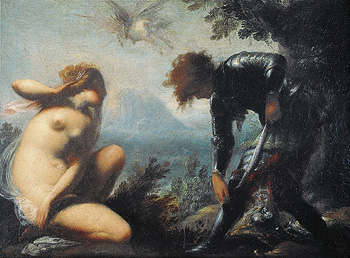 Original
Source
Original
Source
The art of versatility
Four Chicago faculty members
have found reason to include Angelica and Ruggiero
by Francesco Montelatici (known as Cecco Bravo) in Andrew
W. Mellon exhibitions they’ve cocurated at the Smart
Museum. One of the Smart’s earliest acquisitions,
the 12 3/4 x 17 1/2–inch
oil painting (circa 1640–45) depicts the moment in
Ludovico Ariosto’s epic poem the Orlando Furioso just
after the paladin Ruggiero has rescued Angelica, princess
of Cathay, from a sea monster. Eager to ravish the maiden,
Ruggiero struggles with his armor while Angelica magically
disappears and his winged steed flies away.
 Courtesy the
David and Alfred Smart Museum of Art
Courtesy the
David and Alfred Smart Museum of Art |
Through September
14 the painting adorns the title wall of The
Painted Text: Picturing Narrative in European Art,
cocurated by Romance languages & literature professor
Frederick de Armas and Elizabeth Rodini, PhD’95, the
Smart’s Mellon projects curator. Rodini says the Cecco
Bravo is particularly appealing for this exhibit because
it portrays “a moment so clearly derived from a particular
literary source.” An illustrated text of the poem,
lent by Special Collections, is also on display.
In her 2001–02 show A Well-Fashioned
Image: Clothing and Costume in European Art, 1500–1850,
Romance languages & literature professor Elissa B. Weaver
used the artwork to portray “bodies concealed and
revealed.” Earlier in 2001 the painting’s pastoral
qualities prompted Larry Norman, associate dean and master
of the Humanities Collegiate Division, to include it in
The Theatrical Baroque. And in the 1999–2000
show The Place of the Antique in Early Modern Europe,
former associate professor of art history Ingrid Rowland
found that Angelica’s impending disappearance fit
her subtheme “transformation of the antique.”
The painting also has made two visits to museums in Cecco
Bravo’s native Florence, Italy.
—A.B.



![]() Advertising
Advertising
![]() About
the Magazine
About
the Magazine ![]() Alumni
Alumni
![]() UChicago
UChicago
![]()
![]() ©2003 The University
of Chicago® Magazine
©2003 The University
of Chicago® Magazine ![]() 5801 South Ellis Ave., Chicago, IL 60637
5801 South Ellis Ave., Chicago, IL 60637![]() fax: 773/702-0495
fax: 773/702-0495 ![]() uchicago-magazine@uchicago.edu
uchicago-magazine@uchicago.edu